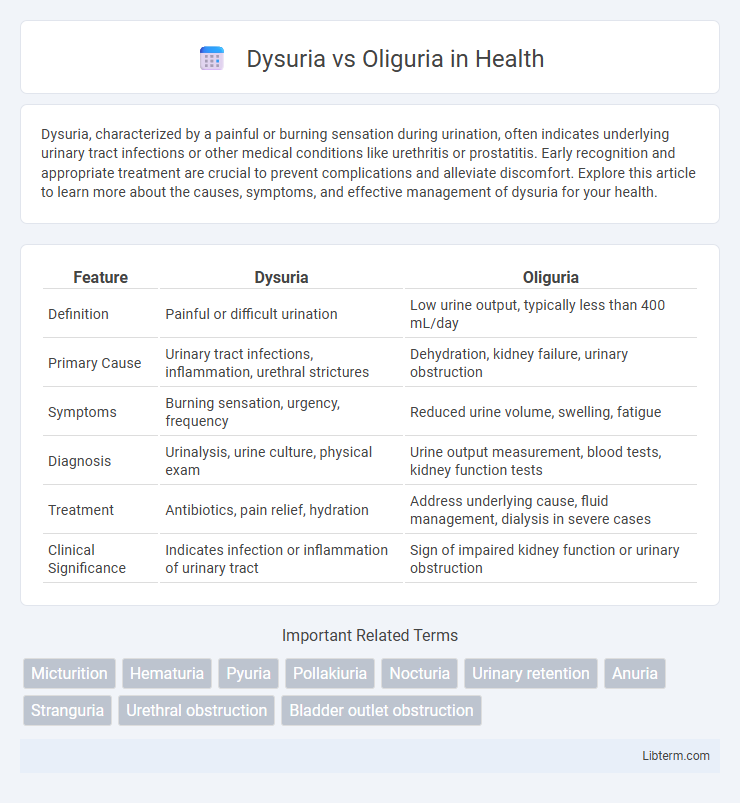Dysuria, characterized by a painful or burning sensation during urination, often indicates underlying urinary tract infections or other medical conditions like urethritis or prostatitis. Early recognition and appropriate treatment are crucial to prevent complications and alleviate discomfort. Explore this article to learn more about the causes, symptoms, and effective management of dysuria for your health.
Table of Comparison
| Feature | Dysuria | Oliguria |
|---|---|---|
| Definition | Painful or difficult urination | Low urine output, typically less than 400 mL/day |
| Primary Cause | Urinary tract infections, inflammation, urethral strictures | Dehydration, kidney failure, urinary obstruction |
| Symptoms | Burning sensation, urgency, frequency | Reduced urine volume, swelling, fatigue |
| Diagnosis | Urinalysis, urine culture, physical exam | Urine output measurement, blood tests, kidney function tests |
| Treatment | Antibiotics, pain relief, hydration | Address underlying cause, fluid management, dialysis in severe cases |
| Clinical Significance | Indicates infection or inflammation of urinary tract | Sign of impaired kidney function or urinary obstruction |
Understanding Dysuria and Oliguria
Dysuria is characterized by painful or difficult urination, often caused by urinary tract infections, inflammation, or irritation of the urinary tract. Oliguria refers to the production of abnormally low urine output, typically less than 400 milliliters per day, which may indicate dehydration, acute kidney injury, or obstruction in the urinary system. Understanding the distinct symptoms and underlying causes of dysuria and oliguria is crucial for accurate diagnosis and effective treatment of urinary disorders.
Key Differences Between Dysuria and Oliguria
Dysuria refers to painful or difficult urination, often caused by urinary tract infections or inflammation, while oliguria describes abnormally low urine output, typically less than 400 mL per day, indicating possible kidney dysfunction or dehydration. Dysuria is a symptom involving discomfort during urination, whereas oliguria is a clinical sign reflecting urine volume abnormalities. Understanding these differences is crucial for diagnosis and management, as dysuria primarily signals infection or irritation, while oliguria suggests impaired renal function or fluid imbalance.
Causes of Dysuria
Dysuria, characterized by painful or difficult urination, commonly arises from urinary tract infections (UTIs), including cystitis and urethritis, as well as sexually transmitted infections like chlamydia and gonorrhea. Non-infectious causes include interstitial cystitis, bladder stones, prostate enlargement, and certain medications or irritants such as soaps or spermicides. Differentiating dysuria from oliguria, which denotes decreased urine output due to dehydration, kidney failure, or urinary obstruction, is crucial for accurate diagnosis and treatment.
Causes of Oliguria
Oliguria, characterized by decreased urine output of less than 400 milliliters per day, is primarily caused by conditions that reduce renal perfusion such as hypovolemia, heart failure, or shock. Acute kidney injury from toxins, infections, or obstruction can also lead to oliguria by impairing glomerular filtration rate. Unlike dysuria, which involves painful urination often due to urinary tract infections or inflammation, oliguria reflects significant kidney dysfunction or systemic hypoperfusion.
Common Symptoms of Dysuria
Dysuria commonly presents with symptoms such as a burning sensation during urination, increased frequency and urgency, and discomfort in the lower abdomen or pelvic area. Unlike oliguria, which is characterized by reduced urine output often linked to kidney dysfunction or dehydration, dysuria primarily indicates inflammation or infection of the urinary tract. Recognizing dysuria's symptomatic profile helps differentiate it from oliguria, aiding in timely diagnosis and treatment.
Common Symptoms of Oliguria
Oliguria is characterized by abnormally low urine output, typically less than 400 milliliters per day, indicating potential kidney dysfunction or dehydration. Common symptoms include dark, concentrated urine, swelling in the extremities from fluid retention, and fatigue due to toxin buildup. Unlike dysuria, which primarily involves painful or difficult urination, oliguria signals a reduction in urine volume rather than discomfort during urination.
Diagnostic Approaches for Dysuria and Oliguria
Diagnostic approaches for dysuria primarily involve urinalysis to detect infections or inflammation, urine culture to identify bacterial pathogens, and pelvic examination in females to rule out gynecological causes. Oliguria diagnosis includes measuring urine output over a 24-hour period, assessing serum creatinine and blood urea nitrogen (BUN) levels to evaluate kidney function, and imaging studies such as renal ultrasound to detect obstructive uropathy or structural abnormalities. Both conditions require targeted laboratory tests and clinical assessments to determine underlying etiologies and guide appropriate treatment interventions.
Treatment Options for Dysuria vs. Oliguria
Treatment options for dysuria primarily involve addressing underlying infections with antibiotics such as nitrofurantoin or trimethoprim-sulfamethoxazole for urinary tract infections. Oliguria management focuses on restoring adequate hydration and correcting underlying causes such as acute kidney injury or obstruction through intravenous fluids, diuretics, or dialysis. Accurate diagnosis through urinalysis, imaging, and kidney function tests is essential to tailor appropriate therapy for both conditions.
Prevention Tips for Urinary Disorders
Maintaining proper hydration by drinking at least 8 glasses of water daily helps prevent dysuria and oliguria by promoting regular urine flow and flushing out bacteria. Practicing good personal hygiene and avoiding irritants such as harsh soaps or synthetic underwear reduces the risk of urinary tract infections, a common cause of dysuria. Regular medical check-ups and managing chronic conditions like diabetes support kidney health and prevent oliguria by ensuring early detection and treatment of potential urinary disorders.
When to Seek Medical Help for Urinary Symptoms
Persistent dysuria, characterized by painful or burning urination, warrants immediate medical consultation, especially if accompanied by fever, blood in urine, or lower abdominal pain, as these symptoms may indicate a urinary tract infection or other serious conditions. Oliguria, defined as a significantly reduced urine output of less than 400 mL per day, requires urgent medical evaluation when associated with swelling, fatigue, confusion, or decreased urine volume despite adequate fluid intake, signaling possible acute kidney injury or severe dehydration. Early diagnosis and treatment are critical to prevent complications such as kidney damage or systemic infection in both dysuria and oliguria cases.
Dysuria Infographic

 libterm.com
libterm.com